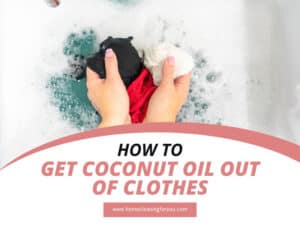Top Ways to Remove Dye Transfer Stains from Colorful Clothes
The questions on how to remove dye transfer stains from colored clothes are frequently asked, which means many people have the same trouble as yours.
If you have not found the perfect solutions yet, reading my sharing today will not waste your time.
Usually, people find the solutions for color marks on white clothes, but those dye marks on colored items are also tricky. Don’t panic; I have several exciting ways to choose from and apply for your situation. It is time to learn more about that!

What Types Of Clothes Can Transfer Dye To Others?
The dye chemicals themselves will not cling to the clothing materials forever. In the daily washing process, you can still see the colors on your clothes fading a bit and a bit gradually.
But to those dyed items which are not appropriately processed or are made of natural fibers (cotton or wool), their dye can easily be washed down. For example, your DIY-dyed clothing is more prone to bleed color to the other clothes than the manufactured ones.
Furthermore, the synthetic fibers (polyesters) can keep their color better since they are added before the fiber-forming process (1), unlike natural fibers (which dyeing process is made after forming fibers).(2)
5 Ultimate Ways To Deal With Those Stubborn Dye Stains
No more beating around the bush; it’s time to learn more about how to eliminate dye-transferred marks on your colored clothing.
1. Detergent

Before moving on to the stronger measure, you might want to try something safer and easier to accomplish first; rewashing with your normally-used detergent (stain-focused types are also great) is one of those.
It would be best if you do this method when the stain is still new. And you don’t need to over-complicate things, just toss your stained clothes back to the washer drum, add in an appropriate amount of detergent and do the setting as usual.
I suggest you refer to the detergent as the clothing manufacturers’ suggestions (on your items’ label).
Notes: If you try a new type of detergent on your clothes, ensure that it won’t harm your clothes by doing a small bleach test on a hidden spot on your clothes.
Remember to only air dry your clothes once the problem is solved.
2. Color Catcher

Color catchers are made of unique material that can collect and catch the running color or bleeding dye when you wash your clothes in the washer. You can also find many of them at any supermarket/online store, and they are also straightforward to apply.
Read the producers’ recommendations and toss the color-catching sheet into the washer drum with other clothes. After that, leave the work for the sheet and your washing machine.
3. Oxygen Bleach (Washer)
I suggest using powdered oxygen bleach (not the liquid) since the powder form will be more stable to deal with, which helps you to receive the best
You Should Prepare:
- Water
- Laundry detergent
- Oxygen bleach (powder)
Notes:
- You can use any types of washing machine you have (front-load/top-load/standard washer)
- Although the water temperature does not affect the performance, don’t use it at freezing temperature.
First, you should mix 1 quart of lukewarm water with bleach powder if you only have cold water on hand.
How To Do:
All you should do next is to put the dissolved bleach into the washer and let the machine do the work.
Once it is done washing, recheck your clothes to see if there are any color marks left. If there are some stained areas left, you should rewash them or soak them in these below-suggested mixtures.
4. Oxygen Bleach (Soaking)
If the two above ways don’t work, it might be time to try this method. Oxygen bleach, unlike chlorine bleach, is much safer to work on your colored clothes. (3) Yet, you still need to do the color fastness test on hidden areas on your garments to recheck.

You Should Prepare:
- Oxygen bleach (powder)
- Cool water
- Sink/bathtub
- Plastic gloves/goggles
You should find a type of oxygen bleach that the clothing producer recommends.
Note: Every time you work with strong chemicals like bleach, always wear plastic gloves before doing.
How To Do:
Here are the steps to accomplish your work.
- Step 1: Create bleach solution mixture (in a sink/bathtub, following the manufacturers’ instructions).
I suggest blending the powder with a hot water cup first, then pouring the mixture into a sink/bathtub of cold water later.
- Step 2: Soak your clothes in the mixture for about 8 hours or more.
If the stains remain after that time, you can redo the process and wait for another 8 hours.
- Step 3: Rinse the bleach mixture off thoroughly with clean water.
- Step 4: Wash your clothes once again as usual.
- Step 5: Hang them on the clothesline or somewhere to air dry.
Note: There is another option just to soak your clothes for around 15 to 30 minutes; you can try that way, too. But if it doesn’t work, you should soak them for 8 hours instead.
Refer to this guide and create the ideal bleaching mixture to remove dye.
Hydrogen Peroxide
This chemical has a significant ability in bleaching and it surely can be used to help with dye stains removal.
Scented Diluted Bleach
This mixture is a slight twist to make your clothes both clean your clothes and add a pleasant smell to them.
You Should Have:
- 1 cup of hydrogen peroxide (bleach) (240ml)
- Essential oils (any type you like, peppermint or lavender)
- Clean water
- A half-gallon container
Solution mix:
- Put the amount of hydrogen peroxide into the container.
- Add more water until the container is full.
- Put in the essential oil scent you like.
And those are all the steps you should follow to create a safe bleach mixture with a lovely scent.
3% Hydrogen Peroxide
This method should only be used with stubborn dye transfer stains! And here are steps to work on that.
- Step 1: Do a small bleaching test on an inconspicuous area of your clothes.
- Step 2: Apply a few drops of 3% hydrogen peroxide directly on the dye stains.
- Step 3: Leave the chemical sit for some minutes.
- Step 4: Rewash your clothes with water.
5. Vinegar
What if you don’t have any bleach prepared on hand? You can try this way and work with white vinegar.

You Should Have:
- 1 cup of white vinegar
- Water (cold)
- Bucket
Solution mix: Put the vinegar you have prepared in the bucket of cold water, blend them well up.
How To Do:
This straightforward guide will assist you; try them out!
- Step 1: Put your clothes into the bucket of solution mixture.
- Step 2: Do a good stir thoroughly so every inch of the stained areas can meet the solution liquid.
- Step 3: Rinse your colored clothes well with fresh, clean water.
- Step 4: Let your clothes air dry naturally.
Notes:
- Although vinegar won’t harm most types of colored fabric, you should do a small bleach test at the corner of your garments to check if it is safe or not before working on the stains.
- You should not try this vinegar method on rayon or acetate fabric; acid acetic in vinegar can weaken those fibers.
- This way is the last way you want to try since vinegar has a strong bleaching ability; only use it when there is no other way around.
Save Your Clothes From Dye Stains Following These Tips
You need to know several things when dealing with stained clothes, if you don’t know what they are, I will provide you with some of them. At the same time, those tips can also help you avoid future color-bleeding issues.
Tip 1: Check The Labels

You don’t want to take the risk and apply bleach/abrasive cleaners on any materials; you need to check if the clothing producers suggest it or not. Missing this tip can make the problem worse or cause another problem like color fading unevenly.
Checking the labels can also help you to avoid washing easy-bleeding clothes with others. Some terms that are typically used to warn you are: “Do Not Use Bleach”, “Avoid Using Detergent”, or “Color May Wash Down,” and so on.
The clothes that have those tags should not be washed together with other pieces to avoid annoying dye stains.
Tip 2: Check Your Clothes’ Pockets For Any Potential Dye Transferring Items
Sometimes, the problems are not from the clothes but from the things you leave inside your pockets. Once those things contact detergents and water, they dissolve, and the color will bleed out, which might stick to the clothes inside the washer drum.
Therefore, ensure to check and empty your clothes’ pockets before washing.
Tip 3: Never Put The Stained Clothes Into The Dryer
When the dye stains are still new, they are not permanent. But when you toss them into the dryer, high heat and the condition inside can help the stains creep deeper into the fabric structure and set permanently.
Tip 4: Empty Your Washer Before Washing
Sometimes, there might be some clothes/items that are left in the washer drum. You have to check if your washer is empty or not before tossing other pieces in to avoid inadvertent accidents.
Tip 5: Never Put Stained Clothes Together With The White Items
You might not want the same problems with your colored clothes to happen the same with those white ones. The stains on your colored items can still bleed out more and create dull marks on the other easy-stained clothes. Separating them when washing or drying is a must.
Tip 6: Wash The Same Color Clothes Together
When washing the same color clothes together and the dye transfers, the stains will not be noticeable. For example, a red cotton shirt can be cleaned with a red wool sweater. And you should do this trick every time before washing.

Tip 7: Watch The Water’s Color While Watching
If you forget one of those things above, they’ll result in bleeding effects. And when the color in the washer changes, you should stop the process right away, find the culprits (a paper/a piece of clothes), and put them out before the issue worsens.
This tip can also help early notice the unwanted color stains on your clothes and solve them promptly.
Tip 8: Never Leave Soaked/Wet Clothes Wait For Too Long

Remember to remove your clothes out of the washing machine every time after washing. Don’t let them stay still for too long since it might increase the chance for their dye to bleed and cling to other items.
To always remember that when your clothes are done washing, you can set a timer or other smart tools to alarm you.
The best instruction on how to stop dye bleed on colored clothes.
FAQs
Frequently asked questions on removing dye and color stains from colored clothes vary. If you still have some questions related to the topic, let’s check the section below.
Say Goodbye To Dye Stains!
You no longer need to be concerned about dye stains on your colored clothing; instead, you can utilize the tips I have offered to deal with them. I hope you can put my advice to good use and find it useful for you and your family.
If you have any more noteworthy ideas to deal with this dye transferring problem, please share them in the comments section below. At the same time, if you have tried any of my suggestions above, please let me know how it went. Loving is sharing.

References
- Fabric focus: Synthetic Fabrics. Love Your Clothes. (2016, September 2).
- Uddin, F. (2019, August 28). Introductory chapter: Textile Manufacturing Processes. IntechOpen.
- Contributor. (2019, March 2). How to use Lye safely. Sciencing.







Samantha Lee
Head Cleaning Expert
Expertise
Professional Home Cleaning, Green Cleaning Techniques, Stain Removal & Fabric Care, DIY Home Maintenance & Organization, Sustainable Cleaning Products, Home Care for Busy Lifestyles
Education
University of Denver
Samantha Lee is the Head Cleaning Expert at HomeCleaningForYou.com, specializing in eco-friendly home care. She holds a Bachelor of Science in Environmental Science from the University of Denver, focusing on sustainable cleaning solutions.
With expertise in green cleaning, stain removal, and DIY home maintenance, she helps homeowners keep their spaces fresh and chemical-free. Samantha has been featured in lifestyle publications and has partnered with brands promoting natural cleaning products.
She also shares practical tips through her blog, online courses, and workshops. Passionate about sustainability, she enjoys testing new eco-friendly cleaning methods and spending time outdoors.